初中英语教学设计
- 格式:doc
- 大小:59.50 KB
- 文档页数:3
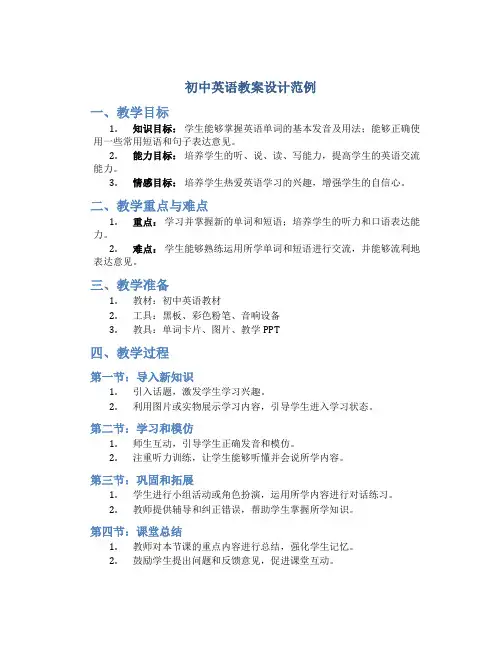
初中英语教案设计范例
一、教学目标
1.知识目标:学生能够掌握英语单词的基本发音及用法;能够正确使用一些常用短语和句子表达意见。
2.能力目标:培养学生的听、说、读、写能力,提高学生的英语交流能力。
3.情感目标:培养学生热爱英语学习的兴趣,增强学生的自信心。
二、教学重点与难点
1.重点:学习并掌握新的单词和短语;培养学生的听力和口语表达能力。
2.难点:学生能够熟练运用所学单词和短语进行交流,并能够流利地表达意见。
三、教学准备
1.教材:初中英语教材
2.工具:黑板、彩色粉笔、音响设备
3.教具:单词卡片、图片、教学PPT
四、教学过程
第一节:导入新知识
1.引入话题,激发学生学习兴趣。
2.利用图片或实物展示学习内容,引导学生进入学习状态。
第二节:学习和模仿
1.师生互动,引导学生正确发音和模仿。
2.注重听力训练,让学生能够听懂并会说所学内容。
第三节:巩固和拓展
1.学生进行小组活动或角色扮演,运用所学内容进行对话练习。
2.教师提供辅导和纠正错误,帮助学生掌握所学知识。
第四节:课堂总结
1.教师对本节课的重点内容进行总结,强化学生记忆。
2.鼓励学生提出问题和反馈意见,促进课堂互动。
五、教学反思与改进
1.对教学效果进行评估,总结教学案例的优点和不足。
2.结合学生反馈意见,进行教学方法和内容的调整和改进。
通过以上教学设计,希望可以有效提高学生的英语学习兴趣,加深对英语知识的理解,培养学生的英语交流能力,让学生在轻松的氛围中学会运用英语表达自己的想法和看法。
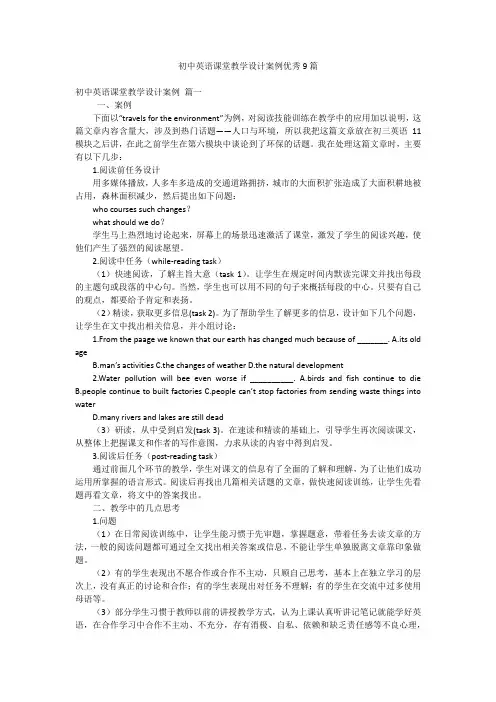
初中英语课堂教学设计案例优秀9篇初中英语课堂教学设计案例篇一一、案例下面以“travels for the environment”为例,对阅读技能训练在教学中的应用加以说明,这篇文章内容含量大,涉及到热门话题——人口与环境,所以我把这篇文章放在初三英语11模块之后讲,在此之前学生在第六模块中谈论到了环保的话题。
我在处理这篇文章时,主要有以下几步:1.阅读前任务设计用多媒体播放,人多车多造成的交通道路拥挤,城市的大面积扩张造成了大面积耕地被占用,森林面积减少,然后提出如下问题:who courses such changes?what should we do?学生马上热烈地讨论起来,屏幕上的场景迅速激活了课堂,激发了学生的阅读兴趣,使他们产生了强烈的阅读愿望。
2.阅读中任务(while-reading task)(1)快速阅读,了解主旨大意(task 1)。
让学生在规定时间内默读完课文并找出每段的主题句或段落的中心句。
当然,学生也可以用不同的句子来概括每段的中心。
只要有自己的观点,都要给予肯定和表扬。
(2)精读,获取更多信息(task 2)。
为了帮助学生了解更多的信息,设计如下几个问题,让学生在文中找出相关信息,并小组讨论:1.From the paage we known that our earth has changed much because of _______. A.its old ageB.man’s activitiesC.the changes of weatherD.the natural development2.Water pollution will bee even worse if __________. A.birds and fish continue to dieB.people continue to built factoriesC.people can’t stop factories from sending waste things into waterD.many rivers and lakes are still dead(3)研读,从中受到启发(task 3)。
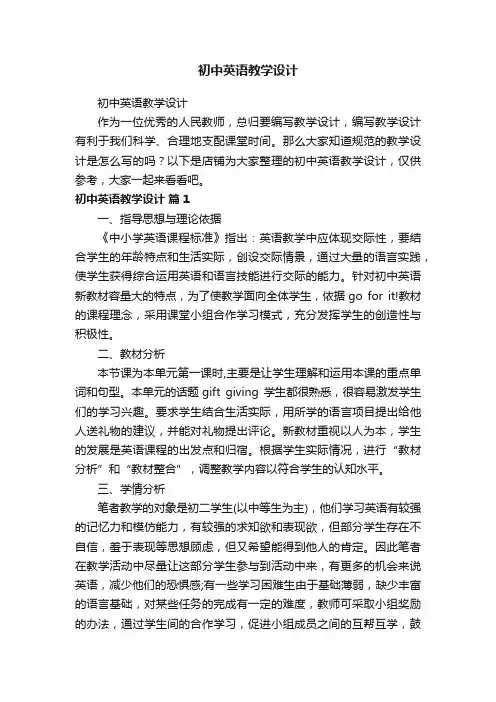
初中英语教学设计初中英语教学设计作为一位优秀的人民教师,总归要编写教学设计,编写教学设计有利于我们科学、合理地支配课堂时间。
那么大家知道规范的教学设计是怎么写的吗?以下是店铺为大家整理的初中英语教学设计,仅供参考,大家一起来看看吧。
初中英语教学设计篇1一、指导思想与理论依据《中小学英语课程标准》指出:英语教学中应体现交际性,要结合学生的年龄特点和生活实际,创设交际情景,通过大量的语言实践,使学生获得综合运用英语和语言技能进行交际的能力。
针对初中英语新教材容量大的特点,为了使教学面向全体学生,依据go for it!教材的课程理念,采用课堂小组合作学习模式,充分发挥学生的创造性与积极性。
二、教材分析本节课为本单元第一课时,主要是让学生理解和运用本课的重点单词和句型。
本单元的话题gift giving 学生都很熟悉,很容易激发学生们的学习兴趣。
要求学生结合生活实际,用所学的语言项目提出给他人送礼物的建议,并能对礼物提出评论。
新教材重视以人为本,学生的发展是英语课程的出发点和归宿。
根据学生实际情况,进行“教材分析”和“教材整合”,调整教学内容以符合学生的认知水平。
三、学情分析笔者教学的对象是初二学生(以中等生为主),他们学习英语有较强的记忆力和模仿能力,有较强的求知欲和表现欲,但部分学生存在不自信,羞于表现等思想顾虑,但又希望能得到他人的肯定。
因此笔者在教学活动中尽量让这部分学生参与到活动中来,有更多的机会来说英语,减少他们的恐惧感;有一些学习困难生由于基础薄弱,缺少丰富的语言基础,对某些任务的完成有一定的难度,教师可采取小组奖励的办法,通过学生间的合作学习,促进小组成员之间的互帮互学,鼓励小组中的优秀成员主动帮助学习困难生,培养学生的团队意识。
提高他们综合运用语言的能力,让他们都能体验到成功的喜悦,使各层次的学生都有所收获。
四、教学目标(1)语言知识目标:引导学生掌握本单元相关的词汇和句型。
(2)语言技能目标:能用所学的语言项目给对方提出建议和意见。
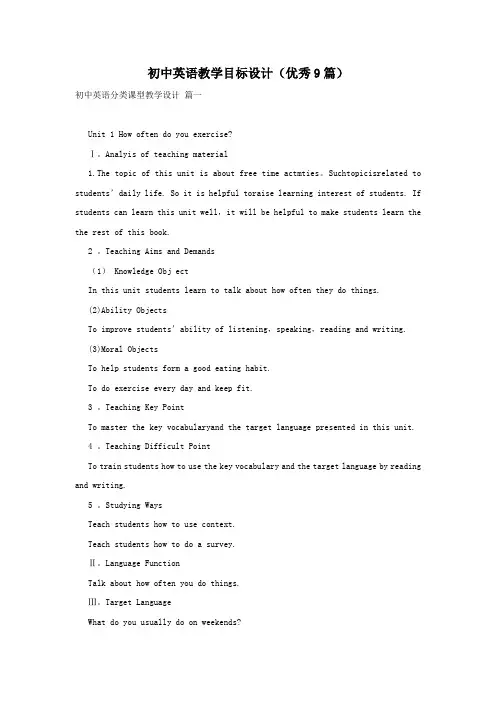
初中英语教学目标设计(优秀9篇)初中英语分类课型教学设计篇一Unit 1 How often do you exercise?Ⅰ。
Analyis of teaching material1.The topic of this unit is about free time actmties。
Suchtopicisrelated to students’daily life. So it is helpful toraise learning interest of students. If students can learn this unit well,it will be helpful to make students learn the the rest of this book.2 。
Teaching Aims and Demands(1) Knowledge Obj ectIn this unit students learn to talk about how often they do things.(2)Ability ObjectsTo improve students’ability of listening,speaking,reading and writing. (3)Moral ObjectsTo help students form a good eating habit.To do exercise every day and keep fit.3 。
Teaching Key PointTo master the key vocabularyand the target language presented in this unit.4 。
Teaching Difficult PointTo train students how to use the key vocabulary and the target language by reading and writing.5 。
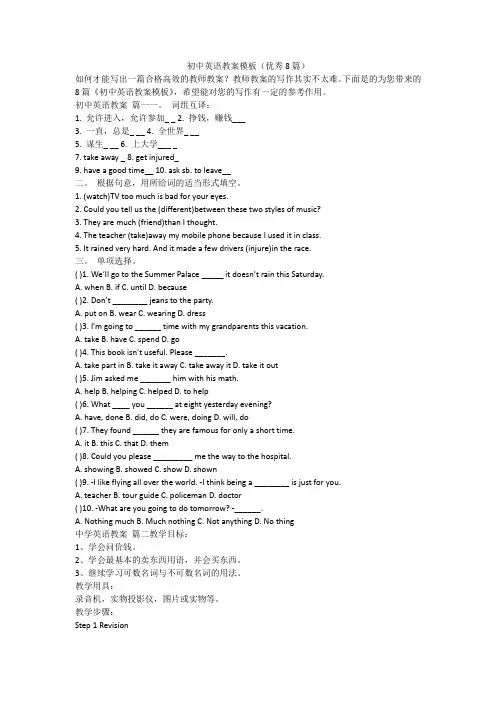
初中英语教案模板(优秀8篇)如何才能写出一篇合格高效的教师教案?教师教案的写作其实不太难。
下面是的为您带来的8篇《初中英语教案模板》,希望能对您的写作有一定的参考作用。
初中英语教案篇一一。
词组互译:1. 允许进入,允许参加_ _2. 挣钱,赚钱___3. 一直,总是_ __4. 全世界_ __5. 谋生_ __6. 上大学___ _7. take away _ 8. get injured_9. have a good time__ 10. ask sb. to leave__二。
根据句意,用所给词的适当形式填空。
1. (watch)TV too much is bad for your eyes.2. Could you tell us the (different)between these two styles of music?3. They are much (friend)than I thought.4. The teacher (take)away my mobile phone because I used it in class.5. It rained very hard. And it made a few drivers (injure)in the race.三。
单项选择。
( )1. We’ll go to the Summer Palace _____ it doesn’t rain this Saturday.A. whenB. ifC. untilD. because( )2. Don’t ________ jeans to the party.A. put onB. wearC. wearingD. dress( )3. I’m going to ______ time with my grandparents this vacation.A. takeB. haveC. spendD. go( )4. This book isn’t useful. Please _______.A. take part inB. take it awayC. take away itD. take it out( )5. Jim asked me _______ him with his math.A. helpB. helpingC. helpedD. to help( )6. What ____ you ______ at eight yesterday evening?A. have, doneB. did, doC. were, doingD. will, do( )7. They found ______ they are famous for only a short time.A. itB. thisC. thatD. them( )8. Could you please _________ me the way to the hospital.A. showingB. showedC. showD. shown( )9. -I like flying all over the world. -I think being a ________ is just for you.A. teacherB. tour guideC. policemanD. doctor( )10. -What are you going to do tomorrow? -______.A. Nothing muchB. Much nothingC. Not anythingD. No thing中学英语教案篇二教学目标:1、学会问价钱。
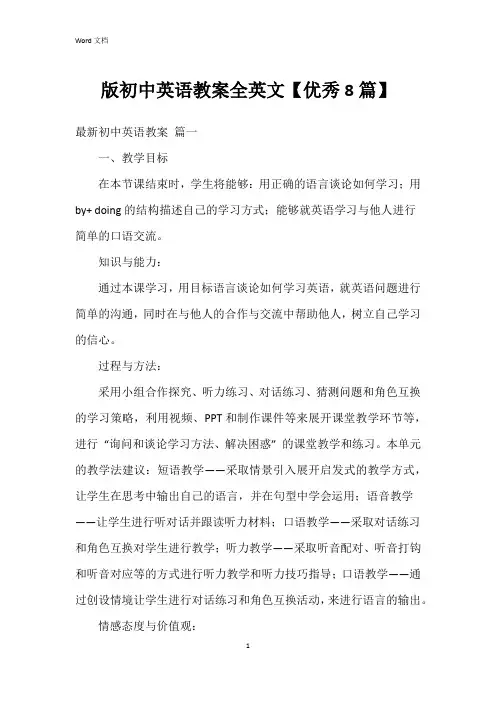
版初中英语教案全英文【优秀8篇】最新初中英语教案篇一一、教学目标在本节课结束时,学生将能够:用正确的语言谈论如何学习;用by+ doing的结构描述自己的学习方式;能够就英语学习与他人进行简单的口语交流。
知识与能力:通过本课学习,用目标语言谈论如何学习英语,就英语问题进行简单的沟通,同时在与他人的合作与交流中帮助他人,树立自己学习的信心。
过程与方法:采用小组合作探究、听力练习、对话练习、猜测问题和角色互换的学习策略,利用视频、PPT和制作课件等来展开课堂教学环节等,进行“询问和谈论学习方法、解决困惑” 的课堂教学和练习。
本单元的教学法建议:短语教学——采取情景引入展开启发式的教学方式,让学生在思考中输出自己的语言,并在句型中学会运用;语音教学——让学生进行听对话并跟读听力材料;口语教学——采取对话练习和角色互换对学生进行教学;听力教学——采取听音配对、听音打钩和听音对应等的方式进行听力教学和听力技巧指导;口语教学——通过创设情境让学生进行对话练习和角色互换活动,来进行语言的输出。
情感态度与价值观:通过参与课题教学活动,增进同学之间的了解和友情,并在交流中了解英语学习的方法,建立学习英语的自信。
二、教学重难点教学重点:学习并掌握How do you study...? I study...by ....等相关句型和词汇。
学习并掌握用by + doing 结构表达方式方法。
教学难点:学习并用丰富的语言描述英语学习的方式和方法。
三、教学策略短语教学——采取视频引入话题然后进行启发式教学,并在对话中运用;语音教学——让学生跟读听力材料进行模仿式操练;口语教学——采取pair work 和Role- play问答式的口语交际活动或小组活动互相操练;听力教学——采取采取听音配对、听音打钩和听音对应等方式语法教学——通过模仿听力材料进行对话练习,在教师的纠正中培养正确的by + doing 的结构意识。
初中英语公开课教案篇二课前准备教师:准备游戏时所用的图片(食物、蔬菜、动物)。
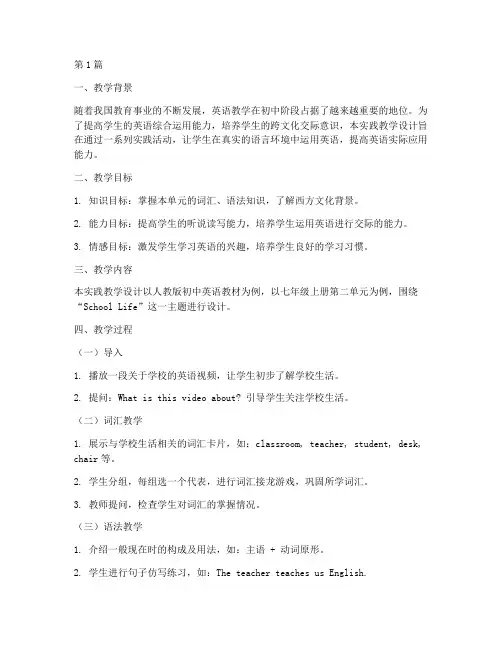
第1篇一、教学背景随着我国教育事业的不断发展,英语教学在初中阶段占据了越来越重要的地位。
为了提高学生的英语综合运用能力,培养学生的跨文化交际意识,本实践教学设计旨在通过一系列实践活动,让学生在真实的语言环境中运用英语,提高英语实际应用能力。
二、教学目标1. 知识目标:掌握本单元的词汇、语法知识,了解西方文化背景。
2. 能力目标:提高学生的听说读写能力,培养学生运用英语进行交际的能力。
3. 情感目标:激发学生学习英语的兴趣,培养学生良好的学习习惯。
三、教学内容本实践教学设计以人教版初中英语教材为例,以七年级上册第二单元为例,围绕“School Life”这一主题进行设计。
四、教学过程(一)导入1. 播放一段关于学校的英语视频,让学生初步了解学校生活。
2. 提问:What is this video about? 引导学生关注学校生活。
(二)词汇教学1. 展示与学校生活相关的词汇卡片,如:classroom, teacher, student, desk, chair等。
2. 学生分组,每组选一个代表,进行词汇接龙游戏,巩固所学词汇。
3. 教师提问,检查学生对词汇的掌握情况。
(三)语法教学1. 介绍一般现在时的构成及用法,如:主语 + 动词原形。
2. 学生进行句子仿写练习,如:The teacher teaches us English.3. 教师巡视指导,纠正错误。
(四)听力训练1. 播放一段关于学校生活的英语听力材料,让学生根据听力内容回答问题。
2. 教师总结听力技巧,如:关注关键词,注意语音语调等。
(五)阅读训练1. 分发课文,让学生自主阅读,了解文章大意。
2. 教师提问,检查学生对文章的理解。
3. 学生分组讨论,分享阅读心得。
(六)口语交际1. 教师设置情景,如:介绍自己的学校,询问同学的学校等。
2. 学生分组进行口语交际练习,教师巡视指导。
(七)总结与反思1. 教师总结本节课所学内容,强调重点和难点。
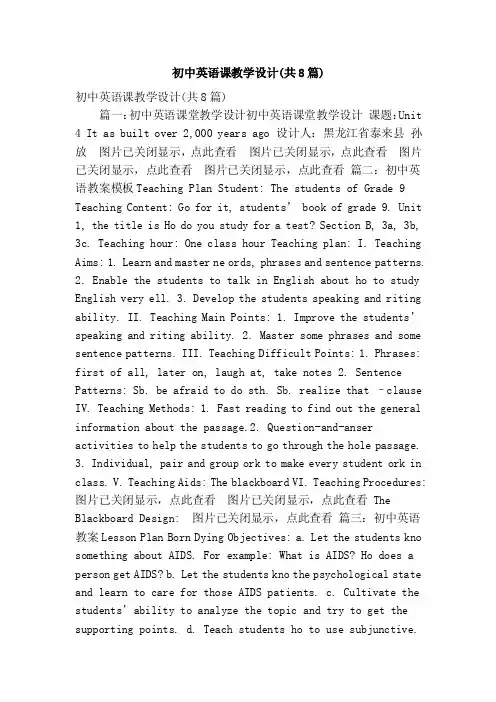
初中英语课教学设计(共8篇)初中英语课教学设计(共8篇)篇一:初中英语课堂教学设计初中英语课堂教学设计课题:Unit 4 It as built over 2,000 years ago 设计人:黑龙江省泰来县孙放图片已关闭显示,点此查看图片已关闭显示,点此查看图片已关闭显示,点此查看图片已关闭显示,点此查看篇二:初中英语教案模板Teaching Plan Student: The students of Grade 9 Teaching Content: Go for it, students’ book of grade 9. Unit 1, the title is Ho do you study for a test? Section B, 3a, 3b,3c. Teaching hour: One class hour Teaching plan: I. Teaching Aims: 1. Learn and master ne ords, phrases and sentence patterns.2. Enable the students to talk in English about ho to study English very ell.3. Develop the students speaking and riting ability. II. Teaching Main Points: 1. Improve the students’ speaking and riting ability. 2. Master some phrases and some sentence patterns. III. Teaching Difficult Points: 1. Phrases: first of all, later on, laugh at, take notes 2. Sentence Patterns: Sb. be afraid to do sth. Sb. realize that –clause IV. Teaching Methods: 1. Fast reading to find out the general information about the passage.2. Question-and-anseractivities to help the students to go through the hole passage.3. Individual, pair and group ork to make every student ork in class. V. Teaching Aids: The blackboard VI. Teaching Procedures: 图片已关闭显示,点此查看图片已关闭显示,点此查看 The Blackboard Design: 图片已关闭显示,点此查看篇三:初中英语教案Lesson Plan Born Dying Objectives: a. Let the students kno something about AIDS. For example: What is AIDS? Ho does a person get AIDS? b. Let the students kno the psychological state and learn to care for those AIDS patients. c. Cultivate the students’ability to analyze the topic a nd try to get the supporting points. d. Teach students ho to use subjunctive.Important Points/Grammar: a. Cultivate the students’ability to analyze the topic and try to get the supporting points. b. Let the students kno those AIDS patients’ psychological state and learn to care for them. c. Teach subjunctive. d. ne ords and phrases:immune system;be inflected ith; survive; suffer from; cheer up; available; persuade. Teaching aids: Pictures, slides, pieces of paper ith different tasks on Procedure Warm-up/Lead-in Activities: Hold a general knoledge test in class by asking some questions related to AIDS, such as hat’s the date of orld AIDS DAY? What’s AIDS? Ho do people get AIDS? What’s the symbol of it? And so on,to stimulate students’ enthusiasm. Stage1, Reading: a. Involve students in reading the text to get familiar ith the content. b. After finishing reading, ask students five questions: 1. What’s AIDS? 2. Ho do people get AIDS? 3. What kind of life does Xiaohua live? 4. What do the AIDS patients suffer from? 5. If you have got ADIS, ho ould you live your rest life? c. Teach students the to important reading methods: skimming and scanning. Then, ask them to read the text once again by using skimming to find the main idea of the text and using scanning to find more specific information of this text.d. After reading, let them present their on ansers of these five questions. Stage 2, Text Explaining: Divide the hole class into 7 groups, every group focuses on one paragraph and finds out the important information hich supports the text. At first, ment the anser of every group. Then explain the text systematically. The text consists of some information as follos: Para1: Xiaohua is?; she is? Para2: AIDS is a disease \ breaks don \ leave \defenseless Para3: via unprotected sex; infected blood transfusion or through birth Para4: Children infect \ the young suffer Para5: not discouraged \ encourage visit \ support \ cheer up \Telling \ encouraging \ creating Para6: Disease\fear \ ignorance \ misunderstanding Para7: “M y life may have to be short, but there is no reason hy itcan’t be beautiful” Introduce to students hat subjunctive is. Then ask students to find out the sentences hich contain subjunctive. The sentences are: 1. I ish my mum ere here ith me and that e eren’t’t sick.2. If I ere to live long enough to have a job, I ould choose to be a doctor, helping these AIDS patients.3. I ish people ould find out the facts and not act as if I ere a bad or dangerous person.4. If I ere you, I ould give an AIDS patient a hug. Stage3, Oral English Practice: First, Let students talk about their dreams about future in small groups by using subjunctive. Then, every group assigns a representative to share his dreams ith the hole class. Stage4, Production: Guided, Meaningful Production Written ork: Ask students to pretend to be Xiaohua’s friends. According to the content of the text, everyone rites a short letter to Xiaohua for greeting. Students are directed to use at least some examples of the structures ithin the text. Then, pick out the best one and read it in front of the students. Homeork: Assign students supplementary reading to practice subjunctive in real context. Assessment.初中英语教学设计 Teaching Aims and Demands: nguage knoledge: Key vocabulary: dining, hall, gym, science, lab, in front of, next, behind, any, one, building Key structure: there be … 2. Reading skill: Teaching Procedures: 教师事先藏好自己的几样东西,上课时假装找不到(注意这时教师要使用丰富的体态语言和脸部表情,让学生感觉到这是真实的),这样就自然地呈现了新的句型:Where is….? It’s on / on / in / in front of / behind / next to… Where are …? They’re on / in / in front of / behind / next to… 设计意图:通过设置让学生帮老师找东西这样一个真实的场景来导入新课,能够立刻调动起学生的参与性,启动学习的发生。
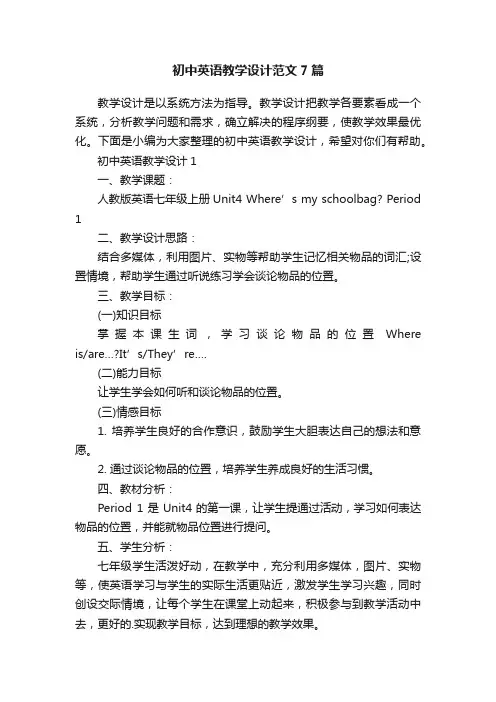
初中英语教学设计范文7篇教学设计是以系统方法为指导。
教学设计把教学各要素看成一个系统,分析教学问题和需求,确立解决的程序纲要,使教学效果最优化。
下面是小编为大家整理的初中英语教学设计,希望对你们有帮助。
初中英语教学设计1一、教学课题:人教版英语七年级上册Unit4 Where’s my schoolbag? Period 1二、教学设计思路:结合多媒体,利用图片、实物等帮助学生记忆相关物品的词汇;设置情境,帮助学生通过听说练习学会谈论物品的位置。
三、教学目标:(一)知识目标掌握本课生词,学习谈论物品的位置Where is/are…?It’s/They’re….(二)能力目标让学生学会如何听和谈论物品的位置。
(三)情感目标1. 培养学生良好的合作意识,鼓励学生大胆表达自己的想法和意愿。
2. 通过谈论物品的位置,培养学生养成良好的生活习惯。
四、教材分析:Period 1是Unit4的第一课,让学生提通过活动,学习如何表达物品的位置,并能就物品位置进行提问。
五、学生分析:七年级学生活泼好动,在教学中,充分利用多媒体,图片、实物等,使英语学习与学生的实际生活更贴近,激发学生学习兴趣,同时创设交际情境,让每个学生在课堂上动起来,积极参与到教学活动中去,更好的.实现教学目标,达到理想的教学效果。
六、重点及其突出方法:充分利用现代教育手段,创设交际情境,为学生提供图像和声音资源,进行语言操练和实践,加强学习效果。
七、难点及其突破方法:培养良好的语言表达习惯。
发挥教师良好的示范作用,注重教师在课堂教学中对学生无意识的影响。
八、教学资源:多媒体;课件;教材九、教学过程:Step anization GreetingsStep 2.Revision1. Use a pen to ask and answer between the teacher and the students, and review the key sentences in Unit3.2. Use a picture of a bag to ask students to write a lost notice and a found notice, and review the lost and found notices, then lead to the new words with the picture(1a:P19).Hold up the picture and point to the objects : table, bed , bookcase, sofa, chair, schoolbag , book, key.T: What’s this in English?S: It’s a table/bed/...Encourage or help students to read the words correctly .Write them down on the blackboard.3. Quick reaction .Let the students look at the teaching picture in 1a, finish 1a, then check students’ answers. Step3. Lead inShow my English book and my two pens, then put them on my desk. Ask students to answer the questions: “Where is my English book?” and “Where are my pens?”.Try to ask more students similar questions:Where is your pencil?...Step3.PracticeAsk the students to look at some pictures and things in the classroom and practice talking about where things are.For example:-where is my clock?-It’s on the table.Ask students to work in pairs and make conversations.Step 4.Talking about the picture(1a:P19)1. Ask the students to practice 1c in pairs.2. Let the students work in pairs and talk about where the things in the picture are on Page19 .Step 5 ListeningHave students to listen to the conversations and number the things.Check the answers . Then ask students to read the conversations after the recording.Step 6 PracticeAsk students to describe their bedrooms.For example: My cat is on the chair. My English book is on the sofa .…Step7 Summary1.--- Where is + 单数主语?… … 在哪?--- It’s under/ on/ in…它在…下面/上面/里面。
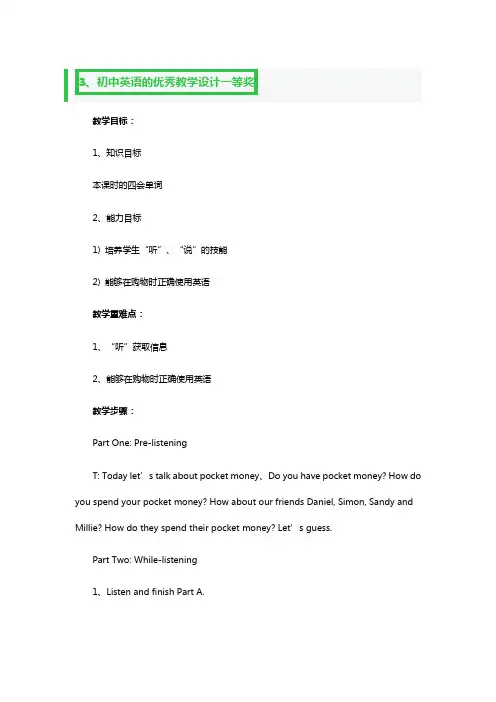
3、初中英语的优秀教学设计一等奖教学目标:1、知识目标本课时的四会单词2、能力目标1) 培养学生“听”、“说”的技能2) 能够在购物时正确使用英语教学重难点:1、“听”获取信息2、能够在购物时正确使用英语教学步骤:Part One: Pre-listeningT: Today let’s talk about pocket money、Do you have pocket money? How do you spend your pocket money? How about our friends Daniel, Simon, Sandy and Millie? How do they spend their pocket money? Let’s guess.Part Two: While-listening1、Listen and finish Part A.T: Please listen to the tape and finish Part A on page 84、Let’s check the answers.2、Listen and fill in the blanks.T: After listening, please fill in the blanks.3、Listen and write.T: Simon often spends money on football cards、What else does he like to buy?Ss: CDs, sports shoes, stationery and T-shirts.T: How often does he buy CDs?Ss: Sometimes.T: How often does he buy sports shoes, stationery and T-shirts? Please listen and answer.Ss: …Do poor children spend pocket money like Simon?Ss: No.T: Please look at the table on page 84、How often do poor children buy CDs?Ss: Never.T: How often do they buy sports shoes, stationery and T-shirts? Please listen again and write down the answers.Ss:…Part Three: Post-listeningT: Please read the advertisement on page 84 and complete the letter on page 85、Let’s read this letter together.Part Four: Speak up1、Listen and answer.T: We know Simon always spends his pocket money on football boots、Today he wants to buy a new pair、How much are the football boots? Please listen and think about this question.Ss: …2、Read and answer.T: Please read after the tape and think about these questions.Ss: …1、Read it in groups.2、Do an activity.T: Suppose you’d like to buy other things、Please work in groups of three and talk about the things in Part C2 on page 85、Use the dialogue in Part C1 as a model.家庭作业:1 Read the dialogue on page 85.2 Complete the following dialogue according to the Chinese sentences.王兰打算买一条尺寸为24号的牛仔裤,可试穿后发现有点小。
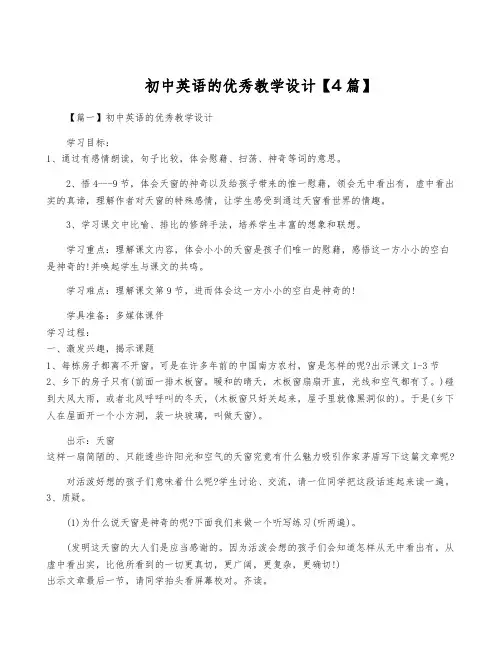
初中英语的优秀教学设计【4篇】【篇一】初中英语的优秀教学设计学习目标:1、通过有感情朗读,句子比较,体会慰藉、扫荡、神奇等词的意思。
2、悟4---9节,体会天窗的神奇以及给孩子带来的惟一慰藉,领会无中看出有,虚中看出实的真谛,理解作者对天窗的特殊感情,让学生感受到通过天窗看世界的情趣。
3、学习课文中比喻、排比的修辞手法,培养学生丰富的想象和联想。
学习重点:理解课文内容,体会小小的天窗是孩子们唯一的慰藉,感悟这一方小小的空白是神奇的!并唤起学生与课文的共鸣。
学习难点:理解课文第9节,进而体会这一方小小的空白是神奇的!学具准备:多媒体课件学习过程:一、激发兴趣,揭示课题1、每栋房子都离不开窗。
可是在许多年前的中国南方农村,窗是怎样的呢?出示课文1-3节2、乡下的房子只有(前面一排木板窗。
暖和的晴天,木板窗扇扇开直,光线和空气都有了。
)碰到大风大雨,或者北风呼呼叫的冬天,(木板窗只好关起来,屋子里就像黑洞似的)。
于是(乡下人在屋面开一个小方洞,装一块玻璃,叫做天窗)。
出示:天窗这样一扇简陋的、只能透些许阳光和空气的天窗究竟有什么魅力吸引作家茅盾写下这篇文章呢?对活泼好想的孩子们意味着什么呢?学生讨论、交流,请一位同学把这段话连起来读一遍。
3、质疑。
(1)为什么说天窗是神奇的呢?下面我们来做一个听写练习(听两遍)。
(发明这天窗的大人们是应当感谢的。
因为活泼会想的孩子们会知道怎样从无中看出有,从虚中看出实,比他所看到的一切更真切,更广阔,更复杂,更确切!)出示文章最后一节,请同学抬头看屏幕校对。
齐读。
(2)你们是不是觉得这段话很难理解?有什么问题吗?估计学生提出的问题有:①天窗、有、无、虚、实、为什么要加引号?②为什么说活泼会想的孩子会从无中看出有,从虚中看出实?③为什么说比他所看到的一切更真切,更广阔,更复杂,更确切?同学们的问题提得很好,弄懂了这些问题,也就是真正理解了这篇课文。
(出示学习目标、齐读)下面我们就来认真读课文,请大家自读课文4--7节。
初中英语课教学设计(锦集4篇)本学期即将结束,在学校领导的关心、指导下,在每一位英语教师的努力下,坚持以人为本,倡导创新精神。
加强教学管理,优化课堂教学。
总结本学期外语教研组的工作,我们一直朝着以下几个方面努力,并取得了一定的成绩。
但也有一些值得思考的、改进的地方,现总结如下:一、强化观念更新,创新英语教学英语新课程标准对英语学科的发展提出了新的要求,这就要求我们要认真学习理论,更新教学观念和知识结构,提高自身的综合素质,才能符合时代潮流的发展要求。
在教学中,我们要求每位教师努力做到"三创新"__创新课堂教学设计,主要以学生的发展为本;创新教学方法,使教学活动由"教"向"学"转变,真正提高45分钟的课堂教学效率;创新教学手段,运用现代化教学技术和远程教育资源是创新外语教学的重要途径。
二、抓好教学业务工作,提高教师的专业素质1.团结协作,发挥集体备课组的优势备课是上好一节课的关键和前提。
我们采取集体备课与个人备课相结合的办法。
备课做到三定(定时间、定内容、定中心发言人)。
四统一(统一教学目的的、统一重点、统一作业内容、统一教学进度)。
集体备课主要以各年级备课组为单位,由各个备课组长负责,每周四第八节课为集体备课时间。
每次备课由1名教师选定一个单元并主讲,明确本单元教学内容的重点、难点、疑点,基本习题,参考教法等。
然后,同年级备课组教师进行讨论,最后达成共识,之后形成文字形式的教案。
充分发挥备课组的力量,做到了教学资源共享。
2.抓好教研组活动这个主阵地,向45分钟要质量课堂教学是学校教学工作的中心,也是教研活动的重要环节。
教研活动的主要方向就是提高课堂教学的水平和教学质量。
因此,英语课堂教学在教研活动中占有重要的地位。
本学期我们每周四下午第八节课定为组教研活动。
每周都有详细的活动安排,本学期共按排了六位教师的公开课和两位教师的师范课,针对课堂教学中出现的情况,提炼共性问题进行研讨,进一步明确了对策建议,使广大英语教师对一些问题有了清晰的认识。
【导语】教育要使⼈愉快,要让⼀切的教育带有乐趣。
⼩编整理了初中英语教案【三篇】,希望对你有帮助!Lesson 71 教学设计⽅案Properties: Recorder, Overhead Projector.Teaching Objectives:1. Revise the grammar: the Adverbial Clause and the Infinitive.2. Revise the use of “who, that, which”.Language Focus: so thatThe Infinitive: to + Verb(原形)Teaching Procedures:I. Showing the teaching aimsII. RevisionCheck homework, ask some students to retell the story.III. PresentationGive the students some sentences for example to help them understand the structure:so + adj. /adv. + that(结果)1. I am so angry that I can't say a word.2. The teacher spoke so fast that we couldn't catch up with him.3. The classroom is so dirty that we must clean it.Ask the students to make up some sentences with “so… that”, then give same more sentences.1. He got up late so that he was late for school.2. He ran very fast so that he hit the electric pole.Ask the students to do some practice.IV. PracticeLook at Exercise 1, ask the students to answer the questions with so that…. The answers are:1. I stayed at home so that I could go swimming when I had finished it.2. Lucy saved her money so that she could buy her mother a birthday present.3. Ling Feng was going to Changsha the next week so that he could visit his sick grandmother.4. I was doing my homework so that I could ask him to help me with my physics.5. I was looking for Lin Tao so that he could visit sick grandmother.V. PresentationGet the students to make up some sentences like:1. I don't know how to get to the station.2. She doesn't know which sweater to choose.Ask the students to pay attrition to the Infinitive. Give them more examples to understand better, e. g.1. I don't know what to do next.2. They don't know where to go.3. We didn't know when to start.Focus on the use of the Infinitive, then give another example:It’s very important to learn English well:To learn English well is very important.Let the students make more sentences, pay attention to the use of the Infinitive.VI. PracticeLook at Exercise 2, make sentences with partners. The answers are:1. It’s hard / easy to work out these maths problem.2. It’s exciting to watch football matches.3. It’s interesting to read history books.4. It’s hard / easy to learn foreign languages.VII. Leaning and practiceDo Exercise 3, complete the sentences using who/ that/ which. The answers are:1.which2.who3.who4.which5.who6.which7.which8.whoVIII. WorkbookDo Exercise 1, let the students translate the sentences alone then check the answers with the students.Answers: 1. We arc hungry. We need to buy something to eat. 2. She is very busy today. She has a lot of work to do. 3. Please be quiet! I have something important to tell you. 4. Will you please tell him to turn down the TV a little? 5. nobody knows what to do next? 6. I’m going to the post office to buy a few stamps this afternoon.For Exercise 2. Join the two parts and make the students read together.For Exercise 3. Get the students to read the story, and fill in the blanks. The answers are: which, who, who, who, who IX. SummaryExercise in classl. 昨天他想借我的收⾳机.2. 我需要⼀些喝的东西。
初中英⽂教学设计模板(精选5篇) 作为⼀位⽆私奉献的⼈民教师,时常需要编写教学设计,借助教学设计可以提⾼教学质量,收到预期的教学效果。
你知道什么样的教学设计才能切实有效地帮助到我们吗?以下是店铺精⼼整理的初中英⽂教学设计模板,欢迎⼤家借鉴与参考,希望对⼤家有所帮助。
初中英⽂教学设计篇1 教学⽬标: 1、能听懂、会说、会读、会拼写词汇look for, join, study 2、能听懂、会说、会读⽇常交际⽤语和句型Classes are over. Perhaps they are. I’ll go and join them. Where are you going? I’m going to … 3、培养学⽣乐于助⼈的良好思想品质。
重点难点: 1、四会掌握词汇和句型。
2、能正确理解掌握并运⽤⽇常交际⽤语。
教学过程: ⾸先是准备环节。
在这⼀环节,⽼师与学⽣交谈彼此的爱好,在轻松愉快的氛围中,拉近⽼师与学⽣之间的距离,为新授课的学习打下良好的铺垫。
其次是复习兼新授(单词与句型的学习)环节。
这⼀环节包括两个步骤,⼀通过看动画图⽚来复习“现在进⾏时”的特殊疑问句,帮助学⽣进⼊这⼀时态的学习⽽做好准备。
⼆以“猜猜看”的游戏来帮助学⽣重温了“现在进⾏时”的⼀般疑问句,在这个过程中引出新单词和句型的学习并进⾏相应的操练,提前把课⽂中的难点解决掉,为下⾯的课⽂学习扫除障碍。
接着是课⽂学习环节。
通过观看课⽂动画⽚,让学⽣做相应的练习来理解和学习朗读课⽂。
然后是巩固环节。
这个环节分三步,第⼀步是以不同的⽅式来让学⽣熟读课⽂。
第⼆步是训练培养学⽣听的能⼒,完成练习“Listen and match”。
第三步是训练培养学⽣写的能⼒,完成练习“Look, read and complete”。
初中英⽂教学设计篇2 ⼀、教学⽬标: 1. 语⾔知识⽬标: 1) 能掌握以下单词: rain, windy, cloudy, sunny, snow, weather, cook, bad, park,message, take a message, could, back, problem 能掌握以下句型: ① —How's the weather in Beijing? —It's sunny. ② —Can I take a message for him? —Yes. Could you just tell him to call me back? —Sure, no problem. 2) 能⽤所学的知识描述天⽓情况。
初中英语备课教案模板【优秀7篇】初中英语教案篇一【学习目标】1.知识目标:学习反义疑问句的用法2.技能目标:提高学生的听说以及闲聊在英语表达中的定义和操练。
3.情感目标:了解聊天的文化知识。
【重点、难点】掌握反义疑问句的运用。
【导学指导】温故知新复习短语go swimming 去游泳wait in line 排队hate doing sth. 讨厌做某事So am / do I 我也是。
It looks like rain 看上去要下雨了。
wait for the bus/ train 等车be late for/to 迟到I hope so/not. 我希望如此/我不希望这样。
自主互助学习1、学生观察1a中的图片相互提问:A:what can you see in picture 1?B: I can see……. A:What are they doing? B: They are …….(学生通过相互提问熟悉图画内容,为听力做准备。
)2、教师让学生归纳1a-2c中所出现的反意疑问句,让学生观察、总结反意疑问句的构成。
知识剖析:反意疑问句要点简述反意疑问句又叫附加疑问句,是在陈述句后,对陈述句所叙述的事实提出的疑问。
其基本结构有两种:一是“肯定陈述句+简略否定问句”;二是“否定陈述句+简略肯定问句”。
反意疑问句的前后两部分在时态、人称和数上都要保持一致。
如:It looks like rain, doesn’t it?He doesn’t need to work so late, does he?几种特殊情况:1. 陈述部分是there be 句型,疑问部分也用there be 句型。
There is a book on the desk, isn’t there?2. 陈述部分如有nothing, nobody, never, few, little, hardly 等否定词时(不包括加否定前缀变来的,如:dislike, unhappy等),疑问部分用肯定形式。
初中英语教学设计3篇初中英语优秀教学设计1国家《英语课程标准》(试验稿)明确“提倡任务型教学途径”。
对此,大家应当有正确的理解。
根底英语课程中心的张连仲教师曾经说过“只要是带着学生参加语言实践的课堂设计,都应当是任务型教学”。
不简单,也不抽象,任务型教学应当是传统模式的进展,也应当是传统教学模式的继承。
作为一个教学论概念,任务是指用所学学问做事,用中学,学中用。
我们应当依据英语运用的真实形态,设计用所学语言构造,在尽可能真实的语境,做一件事情。
同时,教师应根据自己的教学风格设计教学流程。
通过这次观摩研讨活动,我们总结了初中英语课堂设计的思路。
以下内容供教师们参考,同时也盼望教师们多提建议。
任务型听说课教学过程设计思路步骤一:热身预备,激活学生已有学问(1~4分钟)目的:让学生进入上课状态,教师导入教学内容,学生听教师介绍,了解任务。
学生在教师的引导下激活自己已有的学问,预备学习新学问,并激活学习新学问的兴趣,以便完成任务。
步骤二:导入新语言工程(3分钟左右)目的:教师通过肯定的场景导入新语言构造,同时呈现其用法,学生通过真实生活场景接触、理解新语言工程。
步骤三:感受词语(8分钟左右)目的:学生在教材内容刺激下激活已有的词语运用,并学习新词语,形成新的词语运用力量,能精确理解并运用所学新词语的大局部内容。
步骤三:呈现课外、学习课文(10分钟左右)目的:学生进展听力活动、跟读、朗读等活动,教师引导学生学习课文,体会和理解语法、重要句型。
学生经过学习能够把握课文。
步骤四:总结发觉语法规律(3分钟左右)目的:教师引导学生总结语法现象。
步骤五:实践操练语法工程(5分钟左右)目的:教师通过练习和例句,让学生理解语法工程更广泛的用法,同时稳固所学新语法,提高运用新语法的精确性。
步骤六:运用新语言完成任务(10分钟左右)目的:学生通过小组活动等形式完成任务,体验新学学问的真实运用形态,形成在所给语境中运用新语言的力量。
初中英语教学设计【优秀14篇】初中英文教学设计篇一一、教材内容分析本课时中通过字母辨认,图片排序等活动,复习巩固本单元的核心词汇ruler, eraser, book, pen, crayon, pencil box, bag以及打招呼,告别,自我介绍用语。
教学目标是能够辨认相似字母的形以及核心词,并能理解并在场景中应用句型I have … 和Me too.学生刚刚接触到英文的26个字母,对相似字母的辨识还存在着一定的误差,所以教材在Start to read部分安排了字母辨识的环节,例如b和d, Q和D等,目的在于检测和巩固学生对于字母的认识。
本节课的另外一个主要目标是复习和巩固之前所学的一些文具的单词以及打招呼,告别,自我介绍用语等,所以在Read and count, Listen and number和Look and match这三个环节都二、学生情况分析本课教学对象为小学三年级学生。
他们初步接触到英语,对英语的听说感兴趣。
经过前几个课时的学习,学生已经学习了26个英文字母和常见的几种文具,以上是学生学习本课内容的基础。
三、教学目标1、能够辨认字母的形。
2、能够认读本单元的。
核心词:ruler, eraser, pencil, crayon, bag, pen, pencil box, book。
3、检测部分要求学生能够听懂、会说本单元的打招呼、告别及自我介绍用语。
4、能够学会唱歌曲Hello。
四、教学重难点教学重点:听说、认读ruler, eraser, book, pen, crayon, pencil box, bag等文具的名称。
教学难点:在真实的场景中应用句型I have … 和Me too.五、教学步骤1、热身(1)教师与学生进行自由对话:What’s your name? My name is … 既可以巩固本单元句型,同时为下一步歌曲的呈现铺垫。
(2)教师播放歌曲Hello,和学生一起演唱,并让学生从歌曲找出三个人物的姓名。